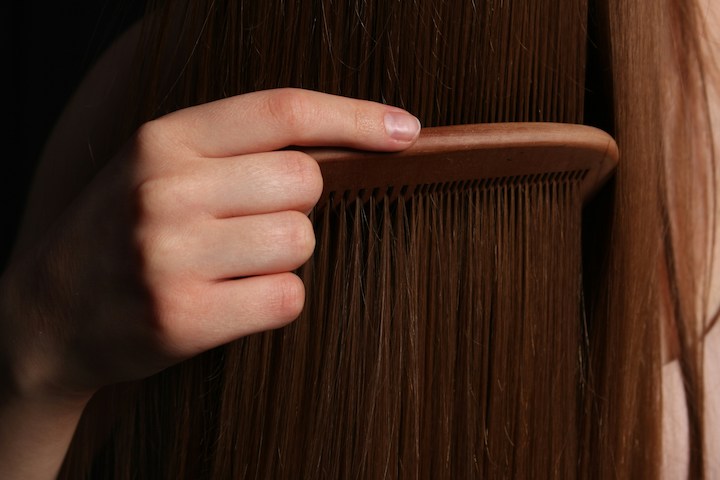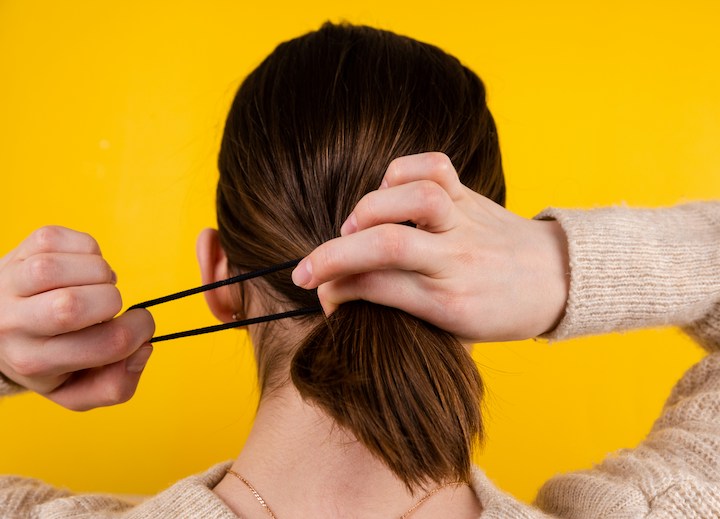You ever tug at a strand of your hair and feel it stretch… and just keep stretching? Like a sad little overcooked noodle?
Yeah, I’ve been there. One moment everything feels fine, and the next your hair is limp, stretchy, weak, and refusing to bounce back no matter what you do. You might not even notice when it starts. Maybe it began after a color treatment. Or maybe after trying that deep conditioner three wash days in a row because it made your curls feel soft. And now your hair’s mushy. No spring. Just squish.
If any of this sounds familiar, don’t panic. Hair elasticity restoration is possible. And you don’t need a whole new routine or a dozen products either.
Let’s take it step-by-step and fix this.
Table of Contents
What Hair Elasticity Actually Means
So here’s the thing. Hair elasticity just means how well your hair stretches and then returns to its normal shape without snapping.
Think of a soft elastic band. You stretch it, and it gently returns to form. That’s what healthy hair does. It has a little give when wet or dry, but it bounces back into shape. That bounce? That’s elasticity.
When hair loses that ability, it stretches too far. It either stays stretched out or snaps in half. You touch it, and it feels fragile. Or worse—it feels too soft, like cooked spaghetti that’s sat in hot water for way too long.

Signs Your Hair Has Lost Elasticity
Not sure if your hair is just dry or if it’s lost elasticity? Here’s what to look for:
- Your hair feels mushy or gummy when wet.
- You stretch a strand and it snaps easily or just stretches endlessly without springing back.
- Curls or waves don’t hold their shape after styling.
- Hair feels overly soft—almost too soft—yet breaks when you try to detangle.
- It lacks bounce. Like it just hangs there looking tired.
If more than one of those sounds familiar, yeah… elasticity might be the issue.
And the good news? You can do something about it.
Also Read: Best Color-Preserving Hair Treatments That Actually Work
Why Hair Loses Elasticity in the First Place
Most of the time, it’s a balance issue—specifically the balance between moisture and protein. Hair needs both, just not in excess.
Here are a few things that throw off that balance:
- Too much moisture: Over-conditioning, daily leave-ins, or always using moisturizing masks without adding any protein.
- Protein loss: Bleaching, coloring, relaxing, and heat styling all chip away at your hair’s protein structure over time.
- Skipping trims: Damage at the ends builds up.
- High heat tools: Flat irons, curling wands, or even hot blow-drying can weaken the hair’s internal bonds.
Now, I’m not pointing fingers here. We’ve all done at least one of these. Some of us have done them all in the same week.
The goal now is to restore that balance—and restore your hair’s ability to bounce back.
How to Gently Restore Hair Elasticity
Let’s go through some simple, friendly steps you can start today. No panic. Just small changes that make a big difference.
Find the Balance Between Moisture and Protein
First step? Ask yourself: has your routine been all about softness? Lots of moisture masks, creamy conditioners, and zero protein?
If yes, your hair probably needs some protein love.
But don’t swing to the other extreme. Just slowly bring things back to center.
Try using a balanced deep conditioner—one that has both protein and moisture. Look for ingredients like hydrolyzed keratin, collagen, or wheat protein paired with aloe, glycerin, or panthenol.
Think of it like feeding your hair a well-balanced meal. No crash diets.
Use a Protein Treatment—but Don’t Go Overboard
A protein treatment can do wonders, especially if your hair’s elasticity is way off.
But here’s the trick: don’t go heavy with the strong ones unless you really need it. Start with a light or medium protein treatment and see how your hair responds.
If it feels stronger but not stiff? You’re on the right track. If it feels dry or brittle after, ease up.
You don’t need to do this every week. Once or twice a month is plenty for most people.
Limit Heat Tools for a While
I know it’s tempting to “fix” your hair by styling it into place. But right now, your strands need a break.
Skip the flat iron. Tuck the curling wand away. If you must blow-dry, use cool or low heat and always apply a heat protectant.
Every time you give your hair a break from high heat, you’re giving it a chance to rebuild.
Clarify Your Hair to Remove Buildup
Sometimes, hair loses elasticity because it’s weighed down by product buildup. That layer of conditioner, oil, cream, and gel? It stops anything good from getting in.
Use a clarifying shampoo once every few weeks to start fresh. Your hair will feel lighter, and your treatments will absorb better.
Just make sure to follow with a gentle conditioner to keep things balanced.
Trim the Most Damaged Ends
Let’s be real: no treatment can revive split or rubbery ends. If your hair’s dragging you down, a small trim—just the worst parts—can make a huge difference.
I know it’s hard to let go of length. But trust me, trimming dead weight makes your whole head feel healthier.
Space Out Wash Days If You Wash Often
If you’re washing every day or every other day, try stretching it out. Frequent washing—even with gentle products—can strip your hair’s natural structure.
Let your scalp rest. Give your hair time to soak up its own oils and rebalance.
You might need to experiment a bit, but even spacing out an extra day between washes can help.
Use Silk or Satin When Sleeping
Cotton pillowcases can tug and dry out your strands overnight.
If you’re trying to restore elasticity, switching to a satin or silk pillowcase—or wrapping your hair with a scarf—keeps things smoother and less stressed while you sleep.
Small move. Big results.
Detangle Gently—Especially When Wet
Hair is at its most fragile when wet. If it’s already lost elasticity, tugging at knots will only cause more breakage.
Use your fingers or a wide-tooth comb. Add a little conditioner or detangler. And take your time.
Trust me, your hair will thank you.
What to Avoid While Trying to Fix Elasticity
Just as important as what you do is what you stop doing—at least for now.
Here’s what to keep off your hair’s plate:
- Over-conditioning: Especially those thick, buttery masks. Give it a break.
- Daily leave-ins: They build up fast. Scale back and see how your hair reacts.
- High heat tools: Even if it looks better styled, it’s not helping the bounce.
- Back-to-back protein treatments: Too much protein can make your hair stiff and brittle. Find your middle ground.
Basically, don’t try to “fix it faster.” Your hair doesn’t need urgency. It needs consistency.
How Long Does It Take to Restore Hair Elasticity?
You’re probably wondering, “How long is this going to take?”
Here’s the truth: there’s no exact timeline. But if you stay consistent, you’ll usually notice changes in a few weeks. It could take a couple of months to see full bounce return, especially if there’s damage involved.
And no—you don’t have to be perfect. You just have to be patient.
Listen to your hair. Some days it’ll feel like it’s bouncing back. Other days, not so much. Keep going anyway.
Check Out: 7 Hair Gloss Longevity Factors That Secretly Steal Your Shine
Personal Encouragement and What I Learned
When my own hair started feeling soft in a weird, stretchy way, I thought more moisture was the answer. I kept adding conditioner. More leave-in. More oils. Nothing worked. It got worse.
The moment I stopped and rebalanced things—brought in some gentle protein, trimmed the ends, and gave it time—everything changed.
I had to slow down. Pay attention. Treat my hair like it was trying to heal, not like it was broken.
That mindset shift? That was everything.
So if you’re frustrated or tired or ready to just throw it all in a bun and walk away—pause. Breathe. Try again tomorrow.
You don’t have to figure it out all at once. Just one good step at a time.

Conclusion
Restoring hair elasticity isn’t about doing more. It’s about doing the right things—at the right time—for your hair.
Start slow. Pay attention. And don’t expect perfection overnight.
Your hair can bounce back. And honestly? So can you.
You’ve got this.
Frequently Asked Questions
How do I know if my hair needs protein or moisture?
Try the stretch test. If your hair stretches and snaps or feels gummy, it probably needs protein. If it’s stiff, dry, or brittle, it may need moisture. You can also look at what you’ve been using lately—too much of either can throw things off.
Can over-conditioning ruin hair elasticity?
Yes. Too much moisture without protein can lead to “hygral fatigue,” where your hair becomes overly soft and stretchy. It feels like it’s melting. Balance is key.
Are protein treatments safe for natural hair?
Absolutely. Just choose the right strength for your hair type and current condition. Start with light protein and work up if needed. And always follow with moisture.
How often should I do a protein treatment?
It depends on how damaged your hair is. Once every 2–4 weeks is enough for most. Strong treatments should be spaced out more. Light ones can be used more often, but always watch how your hair reacts.



